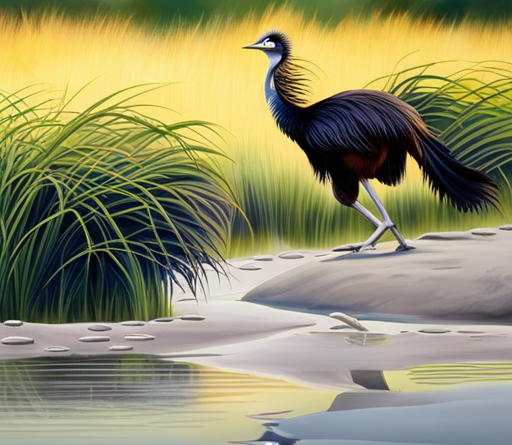
Do you ever wonder about the delicate balance of the ecosystem? How all the different elements work together to create harmony?
Well, one surprising player in this intricate dance is the emu. These magnificent birds are not just fascinating to observe, but they also play a crucial role in maintaining ecosystem balance.
From dispersing seeds to controlling invasive species, emus are key contributors to the health and vitality of their environment. But that’s not all!
Their presence even influences animal behavior and enhances biodiversity. So, let’s delve deeper into the world of emus and discover how their actions shape the delicate web of life around us.
Key Takeaways
- Emus play a crucial role in seed dispersal and vegetation growth, aiding in landscape restoration and promoting biodiversity and ecosystem resilience.
- Emus serve as natural predators, controlling the spread of invasive species and contributing to ecosystem balance and stability.
- Emus contribute to nutrient cycling and soil fertility through their consumption and excretion of plant material, enhancing ecosystem health.
- Emus actively shape the physical environment, conserving water, preventing wildfires, and creating microhabitats that support biodiversity.
Emus as Seed Dispersers
Emus play a crucial role in ecosystem balance by acting as seed dispersers. These large flightless birds have a unique digestive system that allows them to consume a wide variety of plant material, including seeds. As they move through their habitat, emus eat fruits and seeds, which are later excreted in a different location. This process, known as endozoochory, aids in landscape restoration and plant regeneration.
Emus have a significant impact on the dispersal of seeds across their range. Their ability to consume and transport seeds over long distances helps to create a diverse and balanced plant community. By spreading seeds through their droppings, emus contribute to the colonization of new areas, allowing for the establishment of different plant species.
Research has shown that emus prefer to consume seeds with hard seed coats, which are often difficult for other animals to digest. By breaking down these tough coatings and passing the seeds through their digestive system, emus enhance the germination success of these seeds. This process not only aids in plant regeneration but also contributes to the overall health and resilience of the ecosystem.
The role of emus as seed dispersers is crucial for maintaining ecosystem balance and promoting biodiversity. Understanding their impact on landscape restoration and plant regeneration provides valuable insights into the functioning of natural ecosystems. By protecting and preserving emu populations, we can ensure the continued health and vitality of our landscapes.
Impact on Vegetation Growth
To understand the impact of emus on vegetation growth, consider their role as seed dispersers. Emus play a crucial role in maintaining ecosystem balance by consuming various plant species and later distributing their seeds through their feces. This process aids in the dispersion of seeds over vast distances, enhancing the chances of successful germination and new plant growth.
Here are some key points to consider regarding the impact of emus on vegetation growth:
-
Emus and climate change: Emus have the potential to influence vegetation growth in the face of climate change. As temperatures rise and rainfall patterns shift, certain plant species may struggle to survive. Emus, through their seed dispersal role, can help facilitate the migration of seeds to more suitable habitats, assisting in the adaptation and survival of plant populations.
-
Emus and water availability: Water availability is crucial for vegetation growth. Emus can impact water availability through their foraging behavior. By consuming certain plant species, emus may reduce competition for limited water resources, allowing other plants to access more water and thrive.
-
Seed dispersal efficiency: Emus have been found to disperse seeds over long distances, increasing the chances of successful colonization of new areas. This dispersal can lead to the establishment of diverse plant communities and enhance overall vegetation growth.
-
Role in ecosystem dynamics: Emus’ feeding habits can influence vegetation composition and structure. By consuming certain plant species more frequently, emus can shape the dominance of particular plants and impact the overall biodiversity and functioning of ecosystems.
-
Conservation implications: Understanding the impact of emus on vegetation growth is essential for effective conservation strategies. By recognizing their role as seed dispersers, conservation efforts can focus on maintaining and restoring emu populations, ensuring their contribution to ecosystem health and resilience.
Role in Controlling Invasive Species
In controlling invasive species, emus serve as effective natural predators. These large flightless birds have a voracious appetite for a variety of plant and animal species, making them valuable in controlling the spread of invasive species. Emus have been observed to actively hunt and consume small mammals, reptiles, and birds, which are often preyed upon by invasive species. By reducing the population of these prey species, emus indirectly limit the resources available to invasive species, thereby curbing their growth and impact on the ecosystem.
Moreover, emus also play a role in maintaining water quality. Invasive species, such as certain aquatic plants and fish, can disrupt the balance of an ecosystem and negatively impact water quality. Emus, through their feeding behavior, help control the populations of these invasive species, preventing them from overrunning water bodies. By doing so, emus indirectly contribute to the preservation of water quality, ensuring a healthy environment for other organisms.
Overall, emus’ ability to control invasive species makes them valuable assets in maintaining ecosystem balance. Their natural predator instincts and feeding habits help keep invasive species in check, preventing them from dominating and disrupting the delicate ecological balance.
Additionally, their role in controlling invasive species extends to maintaining water quality, further highlighting their importance in preserving the overall health and stability of ecosystems.
Emus and Soil Fertility
Improving soil fertility can be achieved through the role that emus play in nutrient cycling. Emus are large flightless birds that have a significant impact on the ecosystem, including soil health.
Here are five ways in which emus contribute to the improvement of soil fertility:
-
Nutrient Cycling: Emus consume a variety of plant material, including seeds, fruits, and leaves. When they digest and excrete these materials, they release nutrients back into the soil, enhancing its fertility.
-
Seed Dispersal: Emus eat various types of seeds and disperse them across the landscape through their droppings. This process aids in the natural regeneration of plant species, contributing to the overall biodiversity and health of the ecosystem.
-
Tilling the Soil: Emus use their strong legs and beaks to dig for food, which helps to aerate and loosen the soil. This improves water infiltration, root penetration, and overall soil structure.
-
Manure Production: Emus produce a significant amount of manure, which is rich in organic matter and nutrients. When this manure decomposes, it releases essential nutrients that nourish plants and promote healthy soil microbial activity.
-
Weed Control: Emus have a voracious appetite for many types of plants, including invasive and weedy species. By consuming these plants, emus help to suppress their growth and prevent them from dominating the ecosystem, allowing other native species to thrive.
Influence on Animal Behavior
Emus actively shape animal behavior within the ecosystem through their distinctive presence and interactions. Their influence on predator-prey dynamics and habitat restoration is significant. Emus, as large flightless birds, possess a unique ability to deter predators due to their formidable appearance and assertive behavior. Their presence in an area can discourage potential predators from preying on smaller animals, thereby altering the behavior of both predators and prey. This influence on predator-prey dynamics can have cascading effects throughout the ecosystem, leading to changes in population sizes and distribution patterns.
Additionally, emus play a crucial role in habitat restoration. As they move through their environment, emus disturb the soil and vegetation, creating patches of bare ground. These disturbances expose the soil to sunlight, promoting the growth of native plant species and increasing overall plant diversity. The presence of emus also affects the behavior of other herbivores, as they may avoid areas where emus are present, further influencing the distribution of grazing pressure within the ecosystem.
In conclusion, emus have a profound influence on animal behavior within the ecosystem. Their distinctive presence and interactions shape predator-prey dynamics and contribute to habitat restoration. Understanding the role of emus in shaping animal behavior is crucial for maintaining the balance and resilience of the ecosystem.
Transition: Now that we’ve explored the influence of emus on animal behavior, let’s delve into their role as ecosystem engineers.
Emus as Ecosystem Engineers
As an ecosystem engineer, emus actively shape the physical environment through their foraging and nesting behaviors. Emus play a crucial role in water conservation within their habitats. They’ve a unique ability to detect water sources underground, and their strong beaks and clawed feet enable them to dig waterholes, providing access to water for themselves and other species. By creating these water sources, emus help maintain the balance of water in the ecosystem, especially during dry periods.
In addition to their contribution to water conservation, emus also play a role in fire management. Emus are known to consume dry grasses and shrubs, reducing the fuel load that can contribute to the spread of wildfires. Their foraging behavior helps prevent the accumulation of flammable material, reducing the risk of destructive fires.
Emus’ nesting behaviors also have an impact on the ecosystem. They create large nests by scraping out depressions in the ground, which can have important implications for other species. These nests provide shelter and protection for smaller animals, such as reptiles and small mammals, creating microhabitats that support biodiversity.
Emus’ role as ecosystem engineers highlights their importance in maintaining the balance and health of their habitats. By actively shaping the physical environment through their foraging and nesting behaviors, emus contribute to water conservation, fire management, and the creation of microhabitats. Their actions have far-reaching effects, ultimately promoting the overall stability and resilience of the ecosystem.
Contribution to Biodiversity
By creating microhabitats through their nesting behaviors, emus enhance biodiversity within their ecosystems. Emus play a significant role in pollination, as they are known to consume a variety of fruits and seeds, aiding in the dispersal of pollen grains. This can lead to increased plant diversity and the establishment of new populations in different areas. Additionally, emus contribute to nutrient cycling by consuming a wide range of vegetation and depositing nutrient-rich droppings throughout their habitats. This helps to fertilize the soil, promoting the growth of diverse plant species.
To further illustrate the importance of emus in enhancing biodiversity, consider the following table:
| Emus and Biodiversity |
|---|
| Emus and Pollination |
| Emus and Nutrient Cycling |
| Emus and Ecosystem Health |
Emus’ foraging habits and their role as seed dispersers make them valuable contributors to pollination processes in their ecosystems. By consuming fruits and seeds, they ensure the successful reproduction of various plant species. Moreover, emus’ droppings contain high levels of nitrogen and phosphorus, which enrich the soil and support the growth of diverse vegetation.
Conservation of Emus and Ecosystem Health
To ensure the preservation of healthy and diverse ecosystems, it’s crucial to prioritize the conservation of emus and their impact on ecosystem health. Emus play a vital role in maintaining ecosystem balance, particularly in relation to climate change and water conservation.
-
Emus and Climate Change: Emus contribute to climate change mitigation through their feeding habits. As herbivores, they consume large amounts of vegetation, which helps prevent the overgrowth of plants that can contribute to increased carbon dioxide levels. By controlling vegetation growth, emus indirectly assist in reducing greenhouse gas emissions and maintaining a stable climate.
-
Emus and Water Conservation: Emus are well adapted to arid and semi-arid environments and can survive with limited water resources. Their efficient water usage and ability to withstand drought conditions make them valuable in water conservation efforts. By promoting the conservation of emu populations, we can ensure the preservation of precious water resources in regions where water scarcity is a significant concern.
Conservation efforts should focus on protecting and restoring emu habitats to maintain their population numbers. Understanding the vital role emus play in balancing ecosystems and their contributions to climate change mitigation and water conservation is essential for the long-term health and sustainability of our ecosystems.
Frequently Asked Questions
How Do Emus Contribute to the Dispersal of Seeds in Their Ecosystem?
Emus play a crucial role in the dispersal of seeds in their ecosystem. Through their diet, emus consume various fruits and plants, and as they move around, they unknowingly drop the seeds in different locations. This process aids in the plant regeneration and distribution, contributing to the overall balance of the ecosystem.
Emus, as seed dispersers, help ensure the survival and diversity of plant species, ultimately shaping the landscape and promoting a healthy and thriving environment.
What Is the Impact of Emus on Vegetation Growth in Their Habitat?
Emus play a vital role in the growth of vegetation in their habitat. Their constant movement and foraging activities help in the dispersal of seeds, leading to increased plant diversity and abundance.
This, in turn, contributes to the stability of the entire ecosystem. Without the presence of emus, the vegetation growth would be significantly impacted, potentially leading to a negative cascade effect on other organisms that rely on these plants for food and shelter.
Emus truly are ecosystem engineers, shaping the landscape around them.
How Do Emus Play a Role in Controlling Invasive Species in Their Environment?
Emus play an important role in controlling invasive species in their environment. These large birds have a voracious appetite and feed on a variety of plants and insects.
By consuming invasive plant species, emus help to reduce their spread and maintain ecological balance. Additionally, emus are known to prey on small animals, including rodents and insects, which can have a detrimental impact on the ecosystem.
What Is the Relationship Between Emus and Soil Fertility in Their Ecosystem?
In the realm of soil fertility, emus possess a fascinating connection. Their impact on soil composition and quality is akin to a delicate dance.
Through their dietary preferences, emus consume various seeds and plants, which are later digested and excreted. This process aids in dispersing seeds and fertilizing the soil, ultimately enhancing its nutrient content.
As emus traverse their ecosystem, their role in soil fertility becomes evident, leaving a lasting imprint on the delicate balance of nature.
How Do Emus Influence the Behavior of Other Animal Species in Their Habitat?
Emus play a crucial role in shaping the behavior of other animal species in their habitat. Through predator-prey dynamics, they influence the movements and interactions of their potential prey, creating a ripple effect throughout the ecosystem.
Additionally, emus engage in social interactions with other species, such as ostriches, which can lead to changes in their behavior and distribution patterns.
These interactions highlight the interconnectedness of species within an ecosystem and emphasize the importance of understanding the influence of emus on other animals.
Conclusion
In conclusion, emus play a vital role in maintaining ecosystem balance. Despite concerns that emus may disrupt the balance by eating vegetation, their role as seed dispersers and controllers of invasive species actually promotes vegetation growth and biodiversity.
Furthermore, their influence on animal behavior and soil fertility further contribute to the overall health of the ecosystem.
By conserving emus, we can ensure the preservation of a healthy and thriving ecosystem for future generations to enjoy.




